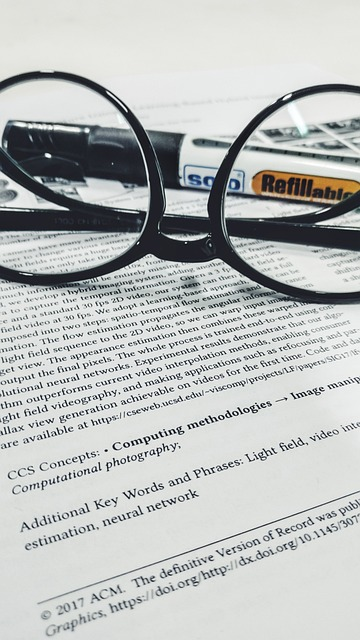Have you ever wondered what it takes to write a groundbreaking scientific paper that advances our understanding of the world around us?
Writing scientific papers is a crucial skill for researchers, academics, and students alike.
A well-written scientific paper not only communicates your research findings effectively but also showcases your critical thinking and analytical skills.
In this step-by-step guide, we’ll walk you through the process of writing a scientific paper, from choosing a research topic to submitting your paper for publication.
How to Write a Scientific Paper in 8 Steps
Writing a scientific paper can seem daunting at first.
So we broke down the process into 8 manageable steps to help you write a paper that is well-structured, informative, and engaging.
Whether you’re a seasoned researcher or a student just starting, this guide will provide you with the tools and knowledge you need to write a compelling scientific paper that stands out from the rest.
Step 1: Choose a Research Topic
The first and most crucial step in writing a scientific paper is choosing a research topic.
Your topic should be both interesting and relevant to your field of study. To identify a suitable research topic, start by reviewing the current literature in your area of interest.
Look for gaps in the existing research or unanswered questions that you could potentially address through your own research project.
Creating a research paper outline to organize key topics, arguments, and evidence can make the writing process more efficient and prevent important information from being overlooked.
When selecting a research paper topic, it’s essential to ensure that it is feasible given your available resources, time, and expertise.
Consider factors such as access to necessary equipment, data, or study participants.
You should also assess whether your topic aligns with your research goals and has the potential to make a meaningful contribution to the greater scientific community.
Once you have identified a potential research topic, it’s important to narrow down its scope.
A broad topic can be overwhelming and difficult to address within the confines of a single scientific paper.
By focusing on a specific aspect of your topic, you can create a more manageable and targeted question for research.
This will help you to develop a clear hypothesis and design a focused research methodology.
For example, instead of choosing a broad topic like “climate change,” you might narrow your focus to “the impact of rising sea levels on coastal ecosystems in a specific region.”
This narrower topic allows you to delve deeper into a specific aspect of climate change while still addressing a relevant and important issue.
Step 2: Conduct a Literature Review
Once you have chosen your research paper topic, the next step in the scientific writing process is conducting a thorough literature review.
Using academic papers as credible sources is essential for a comprehensive literature review.
This involves searching for and analyzing existing research related to your topic.
This step is crucial as it helps you understand the current state of knowledge in your field and identify key concepts, theories, and gaps in the research that your study aims to address.
To begin, use academic databases such as Google Scholar, PubMed, or Web of Science to search for relevant scientific articles and studies.
Use keywords related to your main question to narrow down your search results.
As you read through the previous research, take notes on the main findings, methodologies, and conclusions of each study.
When analyzing the literature, look for patterns, trends, and inconsistencies in the findings.
Synthesize the information from multiple sources to create a comprehensive understanding of your research topic.
Identify the key concepts and theories that are most relevant to your study and consider how your research fits into the broader context of the existing knowledge.
As you conduct your literature review, keep track of the sources you consult.
You’ll need to cite these sources in your scientific paper to demonstrate your understanding of the current research and to give credit to the original authors.
Citing sources is an essential part of academic writing and helps to avoid plagiarism.
By conducting a thorough literature review, you’ll gain a deeper understanding of your research topic and identify the key questions that your study aims to answer.
Step 3: Develop a Research Question and Hypothesis

With a solid understanding of the existing research, the next step is to develop a clear and specific question and hypothesis.
It should be focused, relevant, and address a gap in the current knowledge or explore a new aspect of your research topic.
Qualities of a strong research question
A strong research question should be:
- Specific: Narrow and focused, addressing a specific aspect of your topic
- Measurable: Answerable through empirical research and data collection
- Relevant: Significant and contributing to the broader understanding of your field
- Clear: Clearly stated and easily understood by your target audience
For example, instead of asking, “How does climate change affect ecosystems?” a more specific question could be, “How do rising sea levels impact the biodiversity of coastal wetlands in the southeastern United States?”
This question is directly relevant to the broader context of climate change while focusing on a particular topic that can be investigated through scientific research.
After developing a clear question, create a testable hypothesis.
A hypothesis is a prediction about the relationship between variables based on your question. It should be specific, measurable, and falsifiable.
Qualities of a well-constructed hypothesis
A well-constructed hypothesis should:
- Identify the independent and dependent variables
- Predict the direction of the relationship between variables
- Be testable through empirical research
For example, a hypothesis based on the question above could be, “Rising sea levels will lead to a decrease in the biodiversity of coastal wetlands in the southeastern United States.”
A clear hypothesis provides a roadmap for your research paper.
They guide your research design, data collection, and analysis, ensuring that your study remains focused and relevant.
Step 4: Design Your Research Methodology and Research Paper Outline
The next step is to design your research methodology.
A well-designed methodology ensures the validity and reliability of your findings and is key to writing research papers accepted by peer-reviewed journals.
Tips for Designing a Methodology for your Research
1. Choose an appropriate research design that aligns with your question and hypothesis. 2. Consider the nature of your variables, the level of control you have over them, and the feasibility of your study when selecting your design. The research design you choose will impact the statistical methods you use and the conclusions you can draw. 3. Define your variables and measurement tools. 4. Clearly operationalize your variables by specifying how they will be measured. 5. Identify your independent, dependent, and control variables. 6. Select reliable and valid measurement tools appropriate for your variables and research design. 7. The methods section of your research paper will describe your variables and measurement tools in detail, allowing for replication. 8. Determine your sample size and sampling method. Your sample should be representative of your target population and large enough to detect significant effects. 9. Consider the variability of your variables, desired statistical power, and available resources when determining sample size. 10. Choose a sampling method appropriate for your research design that ensures an unbiased and representative sample.
For example, if you are studying the impact of a new teaching method on student learning outcomes, you may choose an experimental design with treatment and control groups.
The independent variable would be the teaching method, and the dependent variable would be student learning outcomes, measured through standardized tests.
Determine the appropriate sample size based on score variability and desired statistical power, and use random assignment for unbiased groups.
Your manuscript’s results section will present the statistical tests comparing learning outcomes between groups.
A well-designed methodology provides a strong foundation for data collection, analysis, and the conclusions drawn in your research paper.
It demonstrates your understanding of the scientific writing process and your ability to conduct high-quality research that contributes to your field.
Step 5: Collect and Analyze Data

With your research methodology designed, it’s time to collect and analyze your data.
This step involves gathering data using your chosen methods, organizing and cleaning the data, and conducting statistical analyses to interpret the results.
This section is crucial for writing scientific manuscripts that effectively communicate your findings.
Gather data using the methodology you outlined in the previous step.
This may involve conducting experiments, surveys, interviews, or observations, depending on your research design.
Follow your methodology closely and document any deviations or challenges encountered.
Accurate and reliable data collection is essential for producing valid results that can withstand the peer review process when submitting your research paper to scientific journals.
Organize and clean your data. Enter your data into a spreadsheet or statistical software, check for errors or missing values, and code any qualitative data.
Ensure your data is in a format that is easy to analyze and interpret. Well-organized data is crucial for conducting appropriate statistical tests and presenting your results clearly in the results and discussion sections of your scientific article.
Conduct statistical analyses to interpret your results. The specific analyses you use will depend on your research question, hypothesis, and the type of data collected.
Common statistical methods include t-tests, ANOVA, regression, and correlation analyses. Use appropriate statistical software to run these analyses and interpret the results.
When reporting your findings, include relevant statistical information, such as p-values and effect sizes, to help readers understand the significance of your results.
When interpreting your results, consider the statistical and practical significance of your findings. Look for patterns or trends in your data that support or refute your hypothesis.
Consider alternative explanations for your findings and any limitations of your study.
Discussing these key points in your scientific writing demonstrates your critical thinking skills and helps other researchers evaluate the validity and importance of your work.
For example, if you are studying the impact of a new teaching method on student learning outcomes, collect data on student test scores before and after implementing the new method.
Organize this data in a spreadsheet, checking for missing or incorrect values.
Conduct a t-test to compare the mean test scores of the treatment and control groups, looking for a statistically significant effect.
Interpret these results in the context of your hypothesis and the practical implications for teaching and learning, discussing how your findings relate to previous research.
By collecting and analyzing your data carefully and systematically, you ensure that your findings are accurate, reliable, and meaningful. This step is crucial for drawing valid conclusions and making recommendations based on your research, which are essential elements of effective scientific writing.
Step 6: Write Your Research Paper
With your data collected and analyzed, it’s time to write your research paper.
A well-structured paper is crucial for effectively communicating your research to the scientific community. Effective science writing is essential for clearly communicating research findings to specialized audiences.
Follow the IMRaD format (Introduction, Methods, Results, and Discussion) to organize your paper. This logical organization helps readers understand the key points of your research and is the standard format for most scientific journals.
Introduction
Begin your paper with an introduction that provides background information and context for your research. Clearly state your research questions and hypothesis, and explain why your study is important and how it contributes to the field.
A strong introduction sets the stage for the rest of your research article and is essential for effective scientific writing.
Methods
In the methods section, describe your research methodology in detail. Explain how you collected and analyzed your data, including any equipment or software used.
Provide enough detail so that other researchers can replicate your study. Address any limitations or potential sources of bias. A clear and detailed methods section is crucial for demonstrating the validity of your research and is a key component of scientific manuscripts.
Results
Present your findings objectively in the results section. Use tables, graphs, and charts to visualize your data and make it easier for readers to understand.
Report all relevant results, including those that do not support your hypothesis. Avoid interpreting your results in this section. The results section should be clear and concise, highlighting the most important findings of your research.
Discussion
In the discussion section, interpret your results and discuss their implications. Explain how your findings support or refute your hypothesis, and compare your results to past research in the field.
Discuss any limitations of your study and suggest directions for future research. Consider the broader implications of your findings and how they contribute to the larger body of knowledge.
The discussion section is where you demonstrate your critical thinking and analysis skills and is often the most challenging part of scientific writing.
Use clear and concise language, and follow the formatting guidelines of your target journal. Use headings and subheadings to organize your paper. Cite relevant sources to support your arguments and give credit to previous research.
Remember that writing scientific papers is a process, and it may take several drafts and revisions before your manuscript is ready for submission to a peer-reviewed journal.
With practice and persistence, you can develop your scientific writing skills and become a successful author of scientific publications.
Step 7: Edit, Revise, and Understand the Peer Review Process

Once you have completed the first draft of your research paper, it’s essential to edit and revise your work.
This step ensures that your paper is clear, concise, and error-free.
Editing and revising can also improve the overall quality of your writing and make your arguments more compelling. The writing process is not complete until you have thoroughly reviewed and refined your work.
Start by checking your paper for grammatical and spelling errors.
Use a spelling and grammar checker to identify mistakes, but don’t rely on these tools entirely. Read through your paper carefully, sentence by sentence, to ensure that your writing is clear and error-free.
Pay attention to common mistakes, such as using the wrong word or forgetting to include a comma. Misspelled words and poor word choice can detract from the quality of your scientific writing and undermine your credibility as a researcher.
Consider using a text-to-speech tool like Listening.com to listen to your paper and catch any errors or awkward phrasing that you might miss when reading silently.
Next, ensure that your paper follows the proper formatting and citation style for your target journal. Different journals have different requirements for formatting, such as margin size, font type and size, and line spacing.
Make sure your paper adheres to these guidelines and that your references are formatted correctly.
Consistent formatting and proper citation style demonstrate your attention to detail and respect for academic conventions. A well-formatted reference list is a key component of any research paper.
Finally, seek feedback from peers or mentors and incorporate their suggestions into your paper. Ask colleagues or advisors to read through your paper and provide constructive criticism.
They may identify areas where your arguments are unclear or where you need more evidence to support your claims.
Be open to their feedback and use it to improve your paper. Incorporating suggestions from others can refine your writing and make your research more impactful. The review process is an essential part of scientific writing and can help you develop your writing skills and improve your work’s quality.
Remember that editing and revising your research paper is an iterative process. You may need several rounds of revisions before your paper is ready for submission. Don’t be discouraged if your first draft requires significant changes; this is normal in the writing process.
Step 8: Submit Your Paper for Publication

Once you have completed the editing and revision process, it’s time to submit your research paper for publication. Choosing the right journal or conference is crucial for ensuring that your work reaches the appropriate audience and has the greatest impact.
This step can be daunting, especially for graduate students or early-career researchers, but it is essential for disseminating your research and advancing your academic career.
Start by researching potential journals or conferences in your field.
Look for publications that have a scope and audience that align with your research topic and objectives.
Consider factors such as the journal’s impact factor, publication frequency, and acceptance rate.
Aim to submit your paper to the most prestigious and relevant journal or conference that is likely to accept your work.
Keep in mind that most journals have a high rejection rate, so it’s important to have a list of alternative publications in case your first choice does not accept your paper.
Before submitting your research paper, carefully review the submission guidelines and requirements for your chosen publication.
These guidelines will specify the required format, length, and style of your paper, as well as any additional materials that must be included, such as a cover letter or author biography.
Follow these guidelines closely to ensure that your paper is not rejected on technical grounds. Many journals and conferences have specific formatting requirements, such as page numbers, font size, and reference list style, so be sure to pay attention to these details.
Once you have submitted your research paper, be prepared to respond to reviewer comments and make necessary revisions.
Most journals and conferences use a peer review process to evaluate submitted papers, which means that your work will be reviewed by experts in your field.
These reviewers may request changes or additional information to strengthen your paper and improve its clarity and impact. Responding to reviewer comments is an important part of the writing process and can help you refine your research and improve your writing ability.
When responding to reviewer comments, be professional and courteous, even if you disagree with their suggestions. Address each comment individually and provide a clear explanation of how you have revised your paper in response.
If you choose not to make a suggested change, provide a compelling reason for your decision. Remember that reviewers are experts in their field and their feedback can be invaluable in improving the quality of your research paper.
After making the necessary revisions, resubmit your paper and wait for a decision.
If your paper is accepted, congratulations!
Your work will be published and made available to the wider scientific community. This is a significant achievement and can help establish your reputation as a researcher in your field. If your paper is rejected, don’t be discouraged.
Use the reviewer feedback to improve your work and consider submitting it to another publication. Many successful research papers have been rejected multiple times before finding the right home.
Final Thoughts
By following these steps and dedicating yourself to the scientific writing process, you can develop your skills as a researcher and communicator.
Whether you are a student, early-career researcher, or experienced academic, writing scientific papers is essential for advancing knowledge and making a difference in your field.
Start applying the tips and techniques outlined in this guide to your own research projects. With practice and persistence, you can become a successful scientific writer and make a lasting impact on your field.
Remember, the scientific community relies on the contributions of dedicated researchers like you to push the boundaries of knowledge and drive progress in science and society.









